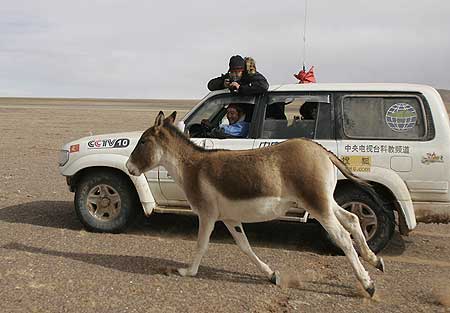Qinghai has the highest concentration of wild donkeys

According to experts’ preliminary research and on-site observation, the wild donkeys are receiving effective protection and multiplying in number in the Sanjiangyuan area (the source of Yangtze River, Yellow River, and Lancang River) as the region’s ecological environment improves.
The wild donkeys have been classified as a Level 1 protected species in the Convention on International Trade in Endangered Species of Wild Fauna and Flora (CITES, a.k.a. the Washington Convention) and the code-red extinction watch list in the 2012 International Union for Conservation of Nature (IUCN); they are also a Level 1 nationally-protected animal in China.
The wild donkeys could be found in Aksai Kazakh Autonomous County, Sunan Yugur Autonomous County, and Maqu County in Qinghai Province and Gansu Province, the Altyn-Tagh Mountains in Xinjiang Uygur Autonomous Region, as well as in western Nagqu, Ngari, and northwestern Shigatse in Tibet, etc.
Experts have found that they are distributed all over Qinghai province, in addition to Haidong, they are especially populous in Yushu Tibetan Autonomous Prefecture, Golog Tibetan Autonomous Prefecture, and Haixi Mongol and Tibetan Autonomous Prefecture.
In the 1980s, the wild donkeys were close to extinction, a far cry from the current robust scene in Sanjiangyuan. Experts believe that in Madoi County of Qinghai Province, there is an average of one wild donkeys per one square km. Madoi County also has the largest number of known groups of wild donkeys.
Based on the current research, the wild donkeys’ distribution, numbers of species, and concentration in Qinghai Province are continuously growing.
For the first time ever, Qinghai Province will use the domestic-produced Bei Dou Navigation Satellite System (BDS) to select seven each of the Tibetan antelopes, Tibetan gazelle, wild donkeys, and bharal for a one or two-year satellite-tracked study. This is the first time China is using a domestically-made satellite tracking system to track wild animals on a large scale.
According to local shepherds in Sanjiangyuan, large wild animals have recovered in number relatively rapidly in recent years, surpassing the number of domestic livestock, and led to an increased pressure on the pasture’s stocking capacity.
While the number of wild donkeys continues to rise, experts have observed that the birth rate for the wild donkeys has not surpassed 10% in Qinghai, which shows that the wild donkeys have not recovered to their strongest state yet.
Your Comment
Name E-mailRelated News
-
;
-
-
Protecting vital water sources in Sanjiangyuan
Sanjiangyuan, China's highest and largest natural wetland reserve, contains key sources of the country's three major waterways.
-
-
-

-
Protecting Sanjiangyuan
After years of a herding ban and large-scale relocation of herdsmen, things are looking better in the Sanjiangyuan nature reserve.
-
-
-
Monks work to keep vital Asian water source Sanjiangyuan healthy
Sanjiangyuan reserve is huge water source for China, and water from the plateau also flows into several other Asian countries.
-
Based in Lhasa, Tibet Vista is a Tibet travel agency that specialized in Tibet permit, and Tibet tours for both private and group travelers at a local price!
•4 Days Lhasa City Group Tour from USD 460 •8 Days Everest Base Camp Group Tour from USD 850 •15 Days Mt.Kailash Group Tour from USD 1780 •2016 Tibet Train Tours from Beijing, Shanghai, Chengdu, Xining,etc










